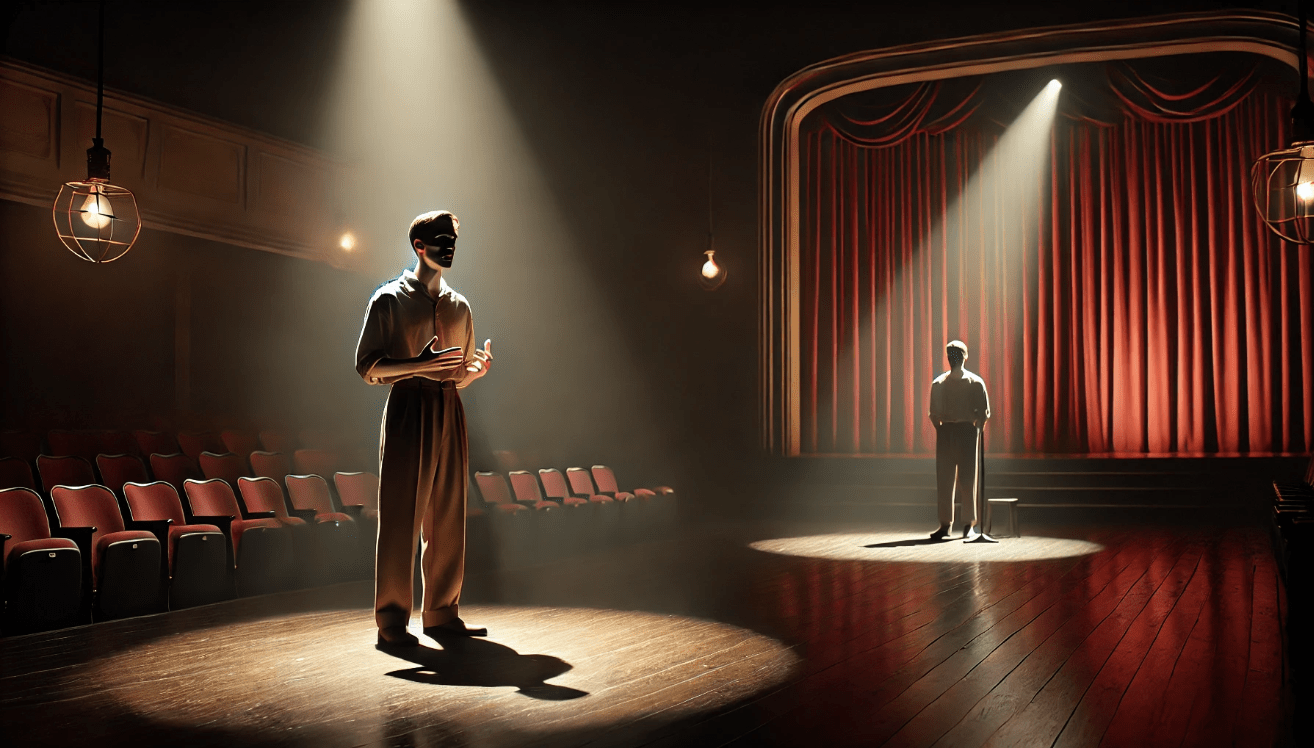
Unveiling Character Insights Through Soliloquies: A Practical Guide for Writers and Students
Ever wondered what a character’s deepest thoughts reveal about their soul? 🎭 Soliloquies in literature and drama offer a window into the minds of complex characters, unraveling their motives, fears, and desires in ways dialogue alone can’t. But why do these solo speeches matter, and how can they transform your understanding of a story? 🤔 This article explores how soliloquies unlock powerful character insights, making you feel closer to the narrative. Whether you’re a student, reader, or theater buff, you’ll discover practical ways to analyze these moments and enrich your storytelling experience. Dive in to uncover the magic of soliloquies! ✨
Table of Contents
Toggle1. Understanding Soliloquies and Their Power

Soliloquies are a writer’s secret weapon. They let characters speak their deepest thoughts aloud, revealing who they are and what drives them. Whether you’re a writer crafting a story or a student analyzing a play, understanding soliloquies can unlock powerful insights. This section breaks down what soliloquies are, why they matter, and how to use them effectively. Let’s dive in! 😊
What Is a Soliloquy?
A soliloquy is a moment in a story or play when a character speaks their thoughts aloud, usually alone on stage or in a private moment. It’s like a window into their mind. Think of Hamlet’s famous “To be or not to be” speech—it’s raw, honest, and reveals his inner turmoil. Soliloquies let readers or audiences connect with characters on a deeper level.
Unlike a monologue, which is often directed at other characters, a soliloquy is a private confession. It’s the character talking to themselves (or the audience), sharing fears, dreams, or plans. For writers, it’s a chance to show what’s beneath the surface. For students, it’s a key to analyzing character motivations.
Why Soliloquies Matter
Soliloquies aren’t just fancy literary tools—they’re game-changers. They reveal a character’s true feelings, often things they’d never say to others. This builds empathy and makes characters feel real. For writers, soliloquies can move the plot forward or add emotional weight. For students, they’re a goldmine for understanding themes and character arcs.

Imagine a character wrestling with a tough choice, like whether to betray a friend. A soliloquy lets you hear their doubts and justifications, making their decision more impactful. It’s storytelling magic! ✨ Plus, soliloquies make your writing or analysis stand out by showing depth and authenticity.
How Soliloquies Create Emotional Impact
Soliloquies pack an emotional punch because they’re raw and unfiltered. When a character speaks alone, there’s no need to hide or pretend. This honesty grabs the reader’s heart. For example, a villain confessing their regrets in a soliloquy might make them more human, even sympathetic.
To maximize impact, keep soliloquies focused and vivid. Writers, use specific details—like a character clutching a locket while confessing their fears. Students, look for how the soliloquy changes the character’s journey or reveals the story’s themes. Ask: What does this moment show about their inner conflict? 🧠
For example, a character might say, “I hold this ring, her ring, and it burns my hand. Do I keep my promise or save myself?” This is short, vivid, and reveals a pivotal choice.
Why Soliloquies Are Timeless
Soliloquies have been around since Shakespeare’s time, and they’re still relevant. Why? Because they tap into universal human experiences—doubt, desire, fear, and hope. Whether you’re writing a modern novel or analyzing a classic play, soliloquies connect us to characters in a way nothing else can. They’re like a heart-to-heart with the audience, making stories unforgettable. 💖
Use soliloquies to deepen your writing or sharpen your analysis. They’re not just words—they’re a character’s soul laid bare. Ready to harness their power? Let’s move to the next section! 🚀
2. How Soliloquies Reveal Character Insights
Soliloquies are like a backstage pass to a character’s mind. They let writers and readers peek into thoughts, feelings, and motivations that might never surface in dialogue. This section explores how soliloquies uncover deep character insights and offers practical tips for writers and students to use them effectively. Let’s unlock the magic of soliloquies! 🎭
Peeling Back the Layers of a Character

A soliloquy strips away pretense. When a character speaks alone, they have no reason to lie or hide. This raw honesty reveals their true self—flaws, dreams, and all. For example, a hero might confess doubts about their courage, making them relatable and human.
Writers can use this to show what drives a character. Students can analyze these moments to understand a character’s core. Ask: What does this soliloquy reveal that we wouldn’t know otherwise? This question unlocks a treasure trove of insights! 🧠
Showing Inner Conflict

Soliloquies shine when characters face tough choices. They let us hear the tug-of-war in their hearts. Picture a character debating whether to forgive a betrayer. Their soliloquy might weigh love against anger, revealing their values and struggles.
For writers, craft soliloquies that highlight this conflict. Use phrases like “Do I dare?” or “What if I fail?” to show the stakes. Students, note how the conflict shapes the character’s actions. Does it push them toward bravery or hesitation? This clarity deepens your story or analysis. ⚖️
Why Soliloquies Are a Writer’s and Student’s Best Friend
Soliloquies are a shortcut to character depth. They let writers create complex, relatable characters without pages of exposition. For students, they’re a clear path to understanding a character’s soul and the story’s heart. Whether you’re crafting a novel or writing an essay, soliloquies offer insights that make your work shine. 🌟
Ready to apply these tips? Let’s move to the next section and keep exploring the power of soliloquies! 🚀
3. Practical Tips for Writers: Crafting Compelling Soliloquies
Soliloquies can transform your writing, giving characters a voice to share their deepest thoughts. A well-crafted soliloquy captivates readers, reveals character depth, and drives your story forward. This section offers practical, beginner-friendly tips to help writers create soliloquies that feel authentic and powerful. Let’s get started! ✍️

Match the Character’s Voice
A soliloquy should sound like it’s coming straight from your character’s heart. A grumpy old sailor won’t wax poetic like a lovesick teenager. Use their unique speech patterns, vocabulary, and personality. For example, a scholar might use big words, while a thief might speak in short, sharp bursts.
Ask yourself: How does this character talk in everyday life? Then, let that voice shine in their private thoughts. This makes the soliloquy feel real and keeps readers hooked. 🎭
Highlight Inner Conflict
Great soliloquies show a character wrestling with a big decision or emotion. Maybe they’re torn between loyalty and ambition or love and fear. Use questions or contradictions to show this struggle. For instance: “Do I stay silent and safe, or speak and risk it all?”
Focus on one key conflict to keep the soliloquy sharp. This clarity makes the character’s turmoil relatable and keeps readers invested in what happens next. ⚖️
Keep It Concise and Focused
Long, rambling soliloquies can lose readers. Aim for brevity while packing an emotional punch. A short soliloquy—say, 50-100 words—can reveal just as much as a long one if you choose your words carefully. Focus on one core idea, like guilt, hope, or a pivotal choice.
For example: “This letter could ruin me. Burn it? Keep it? My hands shake, but my heart knows the truth.” Short, vivid, and straight to the point. Less is more! 💡
Use Vivid Imagery and Sensory Details
Make soliloquies pop with sensory details that pull readers into the moment. Describe what the character sees, feels, or even smells to ground their thoughts. For instance: “The cold steel of this dagger bites my palm—can I wield it against my friend?”
These details make the soliloquy immersive and memorable. Writers, think: What’s in the character’s hands or surroundings? Use those to deepen the scene. 🌟
Tie It to the Story
A soliloquy shouldn’t feel like a random detour. Connect it to the plot or the character’s arc. Maybe it reveals a secret plan, a change of heart, or a reaction to a major event. This keeps the soliloquy relevant and moves the story forward.
For example, if your character just witnessed a betrayal, their soliloquy could explore their hurt and decision to seek revenge. Always ask: How does this soliloquy impact the story? 📖
Use Questions and Self-Dialogue
Characters talking to themselves often ask questions or argue both sides of a dilemma. This mirrors how real people think, making the soliloquy authentic. Try lines like: “Why did I trust her? Am I a fool, or is hope my only path?”
These questions draw readers into the character’s mind, showing vulnerability and complexity. Sprinkle them sparingly for maximum impact. 🧠
Why These Tips Work
These strategies make soliloquies compelling because they focus on authenticity, emotion, and storytelling. By matching the character’s voice, highlighting conflict, and using vivid details, you create moments that resonate with readers. Whether you’re writing a novel, play, or short story, these tips will help your characters come alive.
Ready to craft your next soliloquy? Let’s move to the next section and keep building your skills! 🚀
4. For Students: Analyzing Soliloquies in Literature
Soliloquies are goldmines for understanding characters and stories. They reveal thoughts and feelings characters hide from others, making them key to literary analysis. This section offers students a clear, step-by-step guide to analyzing soliloquies in plays or novels. Whether you’re writing an essay or preparing for a class discussion, these tips will help you shine! 📚 Let’s break it down.
Understand the Context
Start by pinpointing where the soliloquy happens in the story. What events lead up to it? Is the character alone after a major plot twist, like a betrayal or loss? Context sets the stage for why the character is speaking their thoughts aloud.
For example, in Hamlet, the “To be or not to be” soliloquy comes when Hamlet is grappling with life and death after his father’s murder. Knowing this helps you see why he’s so conflicted. Ask: What’s driving this moment? 🕵️♂️
Identify the Emotions
Soliloquies are emotional outbursts, even if they’re quiet ones. Look for the character’s feelings—fear, anger, guilt, or hope. Words, tone, and punctuation (like exclamation points!) give clues. A character saying, “I am lost!” is likely desperate or confused.
Jot down the dominant emotion and back it up with evidence from the text. For instance, Macbeth’s “Is this a dagger” soliloquy drips with guilt and paranoia. Naming the emotion helps you understand the character’s state of mind. 😢
Uncover Hidden Motivations
Characters often reveal secrets in soliloquies they’d never share with others. Look for what’s driving them. Are they planning revenge, hiding fear, or chasing a dream? These motivations explain their actions later in the story.
In Othello, Iago’s soliloquies reveal his jealousy and desire to destroy Othello. Ask: What does this soliloquy tell us about the character’s goals? This unlocks their true intentions and adds depth to your analysis. 🔍
Spot Key Themes
Soliloquies often tie to the story’s big ideas, like love, power, or fate. Look for words or phrases that hint at these themes. For example, Lady Macbeth’s “Unsex me here” soliloquy touches on ambition and gender roles, central themes in Macbeth.
Make a list: What themes pop up? How does the soliloquy connect to the story’s larger message? This strengthens your essay by showing how the character fits into the bigger picture. 🌍
Analyze Language and Structure
The way a soliloquy is written reveals a lot. Notice metaphors, repetition, or questions. A character repeating “Why?” might be confused or desperate. Short, choppy sentences can show panic, while flowing ones might suggest calm reflection.
In Romeo and Juliet, Juliet’s “Gallop apace” soliloquy uses fiery imagery to show her passion. Ask: How do the words and rhythm reflect the character’s mind? This level of detail makes your analysis stand out. ✍️
Why Analyzing Soliloquies Matters

Soliloquies are windows into characters’ souls, making them perfect for essays and discussions. By breaking them down, you uncover insights that deepen your understanding of literature. These skills also help you write stronger arguments and connect with stories on a human level.
5. Common Mistakes to Avoid When Writing or Analyzing Soliloquies
Soliloquies can be powerful tools for writers and students, but they’re easy to get wrong. A poorly crafted or misunderstood soliloquy can confuse readers or weaken your analysis. This section highlights common mistakes to avoid, with practical tips to keep your soliloquies and analyses sharp. Whether you’re writing a story or studying literature, these pointers will help you steer clear of pitfalls. Let’s dive in! 😊
Making It Too Polished
Soliloquies should feel raw and real, not like a rehearsed speech. Writers, avoid overly poetic or formal language unless it fits the character, like a noble king. A farmer’s soliloquy should sound earthy, not like Shakespeare. Students, don’t misinterpret polished language as the main point—focus on what it reveals about the character’s mind.
Read the soliloquy aloud. If it sounds like a lecture, rewrite it to feel more natural, like a stream of thoughts. For example: “I can’t do this… or can I? My hands are shaking.” Authenticity is key! 🗣️
Disconnecting from the Story
A soliloquy that feels random or unrelated to the plot can derail your story or analysis. Writers, ensure the soliloquy ties to a specific event or choice, like a character deciding to confront a rival. Students, don’t analyze a soliloquy in isolation—connect it to the story’s events and themes.
For example, if a character’s soliloquy about betrayal comes after a friend’s disloyalty, highlight that link. Ask: How does this soliloquy move the story forward or deepen the character’s arc? This keeps it relevant. 📖
Why Avoiding These Mistakes Matters
Dodging these pitfalls ensures your soliloquies resonate with readers and your analyses score high marks. Writers, you’ll create characters that feel alive and stories that grip. Students, you’ll uncover deeper insights and write essays that stand out. Avoiding these mistakes turns good work into great work.
6. Real-World Applications: Using Soliloquies Beyond Literature
Soliloquies aren’t just for Shakespeare or novels—they have surprising uses in everyday life, from creative projects to personal growth. Writers and students can apply soliloquy techniques to make their work more engaging or to better understand themselves and others. This section explores practical, real-world ways to use soliloquies outside literature. Let’s see how this literary tool can shine in new contexts! 😊
Soliloquies in Scriptwriting and Film
In movies and TV, soliloquies bring characters’ inner thoughts to life. Think of a character narrating their fears while staring out a window. Writers can use soliloquies in scripts to reveal emotions or motives without clunky dialogue. For example, a superhero might whisper doubts about saving the day, making them more relatable.
Soliloquies in Public Speaking and Presentations
Soliloquy-style techniques can make speeches more engaging. By sharing a personal, reflective moment, speakers connect with audiences. For instance, starting a talk with “I stood alone, wondering if I could do this—sound familiar?” grabs attention and feels authentic.
Soliloquies in Teaching and Education
Teachers and students can use soliloquies to make learning interactive. In history class, students could write soliloquies for historical figures, imagining their thoughts before a big event. For example, a soliloquy for Joan of Arc might reveal her courage and doubt before battle.
Soliloquies in Marketing and Storytelling
In advertising, soliloquy-style narratives create emotional connections. A commercial might show a character reflecting alone, like a parent thinking, “Can I give them the future they deserve?” This draws viewers in by tapping into universal feelings.
Avoiding Overuse in Real-World Settings
Soliloquies are powerful but can feel forced if overdone. In scripts or speeches, use them sparingly to avoid sounding melodramatic. In personal reflection, don’t let them turn into endless rants—focus on one key thought. For example, a soliloquy about a career choice should zero in on the decision, not every life detail.
Why Soliloquies Work in Real Life
Soliloquies connect people to emotions and stories, whether in a movie, speech, or journal. They make characters, speakers, or even your own thoughts feel real and relatable. By practicing soliloquy techniques, writers and students can boost creativity, empathy, and communication skills in any setting.
 Soliloquies are more than just dramatic speeches—they’re a powerful tool for revealing character depths and connecting with audiences. For writers, they offer a way to craft authentic, emotional moments that make stories unforgettable. For students, they unlock insights into characters, themes, and narratives, boosting analysis skills. 😊
Soliloquies are more than just dramatic speeches—they’re a powerful tool for revealing character depths and connecting with audiences. For writers, they offer a way to craft authentic, emotional moments that make stories unforgettable. For students, they unlock insights into characters, themes, and narratives, boosting analysis skills. 😊
By mastering soliloquies, you can create compelling characters, ace literary essays, or even apply their techniques to real-world scenarios like speeches or personal reflection. Avoid common pitfalls, keep the character’s voice authentic, and tie every soliloquy to the story’s heart. Ready to harness their power? Start writing or analyzing today, and let soliloquies bring your stories and studies to life! 🚀
Frequently Asked Questions (FAQs)
1. What is a soliloquy and how is it different from a monologue?
A soliloquy is a speech where a character speaks their thoughts aloud, usually alone on stage, revealing their inner feelings. A monologue, on the other hand, may be directed to other characters or the audience. Soliloquies offer deeper insight into a character’s mind.
2. Why are soliloquies important for character development?
Soliloquies help readers or viewers understand a character’s true motivations, fears, and conflicts. They strip away external dialogue and reveal the raw, unfiltered thoughts of the character, making them feel more human and relatable.
3. How can writers use soliloquies to create stronger characters?
Writers can use soliloquies to show what a character really thinks, especially when their actions say otherwise. It’s a great tool to build tension, reveal secrets, or create emotional depth without needing other characters present.
4. What are some common mistakes when writing soliloquies?
A common mistake is making the soliloquy too long, unnatural, or overly poetic. Keep the language true to the character’s voice and avoid info-dumping—focus on one key emotion or conflict at a time.
5. How can students analyze soliloquies in literature effectively?
Start by identifying the main emotions, conflicts, and changes in tone. Ask: What does this reveal about the character? How does it move the plot forward? Look for literary devices like metaphors and repetition to understand deeper meaning.
6. What are some famous examples of soliloquies in literature?
Shakespeare’s plays are filled with iconic soliloquies, like Hamlet’s “To be or not to be” or Macbeth’s “Is this a dagger.” These speeches show internal struggle and give timeless insight into human nature.
7. Can soliloquies be used in modern writing or screenplays?
Yes! Soliloquies still work in modern novels, films, and plays. Think of voice-overs in movies or a character writing in a diary—these are modern takes on soliloquies that let the audience inside their heads.
8. How do soliloquies enhance the reader or viewer’s experience?
Soliloquies make characters feel real by showing their private thoughts and emotions. This builds empathy, adds drama, and gives the audience a unique perspective they wouldn’t get from dialogue alone.
